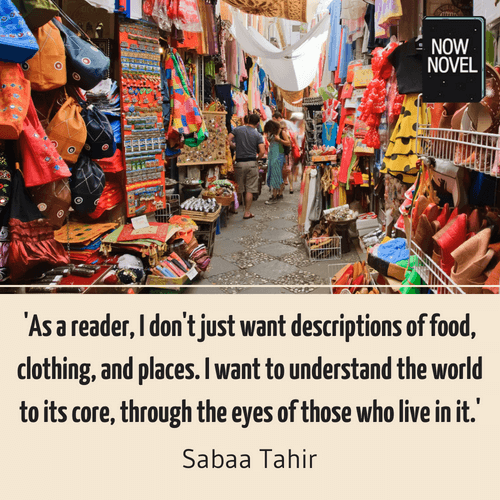How To Identify The Setting Of A Story
What is the setting of a story? Setting has two broad elements: Place and time. In a novel, it'southward where and when the events of your chapters unfold. Read on for tips on creating detailed, involving settings in your story:
Why is setting important? The functions of time and place in fiction
Setting is more than merely a geographical location or fourth dimension catamenia that serves as a backdrop to characters' actions. Fictional settings have many uses:
Using identify in story settings:
'Identify' in a story has multiple purposes and effects:
- The places you set your scenes contribute mood and tone (a dark, eerie wood creates a very different sense of danger or mystery compared to a bright, open manifestly)
- Places restrict (or open) possibilities for your characters' lives and actions (a character living in a small mining boondocks might take very different perceptions and options compared to a graphic symbol who lives in a big city)
- Places tin evolve and change as your story progresses. You can use their evolution to show the changing circumstances affecting your characters' views and options (for example, in Brideshead Revisited by Evelyn Waugh, the narrator visits a chiliad manor he knew in his youth. He finds information technology crumbling due to the onslaught of the state of war. This creates melancholic nostalgia. Waugh uses changing physical setting to convey the thought of loss.)
Fourth dimension is an every bit important element of setting:
Using time in setting
It would exist incomplete to answer 'what is story setting?' without including time. Time in a story, for example the historical menstruum or epoch the story spans, is equally vital:
- Like place, time (for example, the social attitudes in the Victorian era) restricts or rather determines, to some extent, possibilities for your characters.The time setting of your novel impacts what types of lives your characters can lead and what choices they can make. Setting drives plot. Characters living in Victorian England will have very different choices and lifestyles available to them compared to characters living in contemporary England (women, for example, are far less pressured to ally and exist homemakers)
- Time in your novel'due south setting determines what kind of technology is available (historical fiction oftentimes describes onetime-fashioned tools such every bit manual apparel washers that virtually modern city-habitation readers wouldn't know)
- Time in your story settingis every bit useful for showing and underscoring changes that contribute to grapheme and plot evolution (due east.g. changes of regime, scientific discovery, social beliefs and community)
At present that nosotros've clarified some of the functions of time and place in fiction, here are five tips on getting these elements of setting right:

Allow'southward unpack these ideas:
ane: Enquiry and plan places in your story
Inquiry the place y'all are writing almost thoroughly, if it's a real-world location. If, for instance, you're writing near Ancient Rome, find books or websites that outline Ancient Roman compages, society, community and behavior.
One mode to form a deeper sense of whereyour story volition take place is to draw a rough map of master locations. This document could give you an idea of how characters will get from place to place. Create a novel outline using the Now Novel dashboard and outline core settings for your story using easy prompts.
Even if you are inventing your own fictional world entirely, gain a keen sense of how your world is laid out to aid your imagination. Many fantasy novels brainstorm with maps of peninsulas or continents, lending the mythical earth a stronger sense of tangible, measurable reality.
2: Use place like you lot would a character
We give characters individual voices to make them experience real, so that the cast members of our novels don't feel like 2-dimensional carbon copies of each other. But like a character, a place in your novel should have its own 'vox'. Write place like you would write a graphic symbol:
- Create physical descriptions that make place memorable and distinctive: What is the setting of your story famous for? Are at that place significant landmarks? Is there a general atmosphere of decay, or is your setting a thriving, young hamlet or urban center?
- Develop place: How will your setting alter over the course of your story? Do characters' actions and choices bear on their surrounds and vice versa? How does society as a whole chronicle to its surrounds? Is at that place climate modify? What furnishings will time have on place and how will this affect your characters in turn?
Brainstorm vivid settings
Brainstorm ideas and settings in structured steps, then plan your story'due south scenes and world.
START

3: Utilize Google Street View and other tools to plan story settings
This advice comes courtesy of Suzannah Windsor Freeman's excellent post on writing about identify, '7 tips for writing about places you've never been'. Equally Freeman cautions, writing about a real world place yous oasis't visited is risky. You might use outdated place information or settings that are tourists traps and non places actual locals would visit.
Freeman suggests several useful strategies for writing near a place setting you've never seen in person:
- Apply Google Street View to accept your ain virtual walking tour
- Conduct email interviews with locals (Freeman suggests finding people to interview via local blogs and social media)
- Read local regime websites that provide information and statistics on local ways of life
If y'all're creating a fabricated-up place for your novel, imagine what Google Street View would show you if you lot moved along chief streets or alleyways of your setting.

4: Combine factual and fictional sources
When you are writing a novel about a foretime era or lost culture, you can't exactly take a Google Street View tour. In this case, borrow from factual books about the lives, art and compages of your called place and fourth dimension catamenia. If possible, find books written past people who inhabited your chosen place in the fourth dimension you're writing about.
If, for example, you were writing nigh ancient Hellenic republic in the year 350 BC, you could read the writings of people who lived during this time (Aristotle, for example) to get a sense of how people expressed themselves and felt virtually their world.
When archival materials are deficient, y'all can too rely on the work of good authors who take based their fiction in the same setting. Even if writing about invented settings, look for details and ideas you tin can borrow from other places.
5: Build private elements of place and time
To create a conceivable setting for your novel, plan each element of setting consciously. Courtney Carpenter's blog post for Writer'south Assimilate on the basic elements of setting in a story gives the following list of basic setting elements:
- Locale: Eastward.g. country, region, urban center likewise as smaller locations (a schoolhouse, a hospital, or some other specific setting)
- Time of year: This may be seasonal (e.g. Christmas in Dickens' novella A Christmas Ballad)
- Time of day: Think well-nigh how the fourth dimension of day in which a scene is set up can influence the tone and atmosphere. Nighttime can be more than ominous or eerie than the mean solar day
- Climate: Remember about the natural elements of your setting also as the man-made ones
Make notes on the most of import elements of setting for each scene before yous draft it, so that you can keep these details in mind and furnish your scene with extra, brilliant particular.
Stories that are mostly characters' inner monologue or dialogue with no sense of their surrounds can feel adrift, without anything to ballast them. Apply the suggestions higher up to place your characters in the world and show the two-way effects betwixt characters and their environment.
Begin and refine your setting ideas using Now Novel's uncomplicated, pace-past-stride story building tools.
How To Identify The Setting Of A Story,
Source: https://www.nownovel.com/blog/what-is-story-setting/
Posted by: hoffmanabad1967.blogspot.com


0 Response to "How To Identify The Setting Of A Story"
Post a Comment